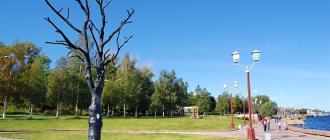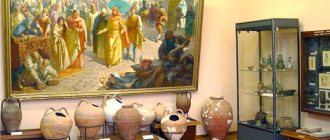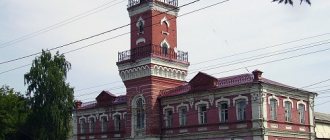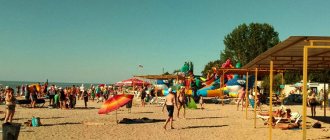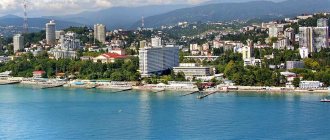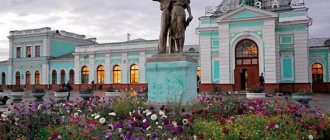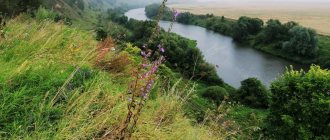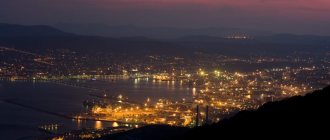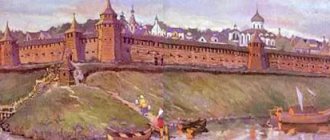The central city beach of the city of Azov is located 40 km from Rostov, across the fairly wide Azovka River, on the banks of the Don River.
The beach area is not particularly popular among visitors, but for local residents it is a favorite place for walks, picnics and sports. The place is suitable for both a family holiday and a pleasant time with friends.
The recreation area at the City Beach itself is not very large. The coastal part cleared of reeds is about one hundred meters. True, there is also a grassy part where you can easily find shade under the trees.
The shore is flat, sandy, without stones and with a fairly convenient entrance to the river. The bottom is dirty and muddy, but the water is clean and warm. The river is shallow, so it is perfect for families with children. In summer, the water here warms up very quickly.
© Sveta Mikhailova
Infrastructure of Azov City Beach
Recently, the territory of the City Beach has changed for the better. The recreation area has become relatively clean and well-maintained. At the entrance to the beach, there are stands on both sides with information about the beach area.
The amenities necessary for sunbathing and swimming are minimal: there are wooden changing rooms, gazebos, canopies, benches and a free barbecue area. There is a summer cafe-tent that serves beer and various soft drinks. During the peak season, vendors also appear here selling pies and hot corn.
You can sit down for a picnic at gazebo tables, which are located separately in the paid area. For lovers of active entertainment, there is a sports ground on the territory of the City Beach where you can play volleyball or football.
© Vitaly Kondyrev
For those who prefer to spend time fishing, there is a suspension bridge on the Azov River side. Here fishermen catch different fish: sebel, ram, carabas.
Among the disadvantages of the Central Beach of Azov, it is worth noting the lack of a toilet and a huge amount of garbage mixed with broken glass.
Literature
- // Cities of Russia: encyclopedia. - M.: Great Russian Encyclopedia, 1994. - P. 14-15. — 559 p. — 50,000 copies. — ISBN 5-85270-026-6.
- Arutyunov G. B. Orthodox churches of Azov. Memorable Orthodox places / G. B. Arutyunov // Arutyunov G. B. Azov is a famous name. — Azov: Inf.-publishing. , 2009. - 96 p.
- Glushchenko V.V. Cossacks of Eurasia: origin, development, integration into the structure of Russian statehood / V.V. Glushchenko. - M.: University Book, 2000. 296 p.
- Lunin B.V. Essays on the history of the Donya-Azov region. From ancient times to the 17th century. Book 1 / B.V. Lunin. - R.-on-D. : Rostovsk. bark, book publishing, 1949. - 184 p.
- Nikolaeva M.V. Narration about the history of Azov and the Azov campaigns of Peter I as part of the “Detailed Chronicle” / M.V. Nikolaeva // Academic. zap. Leningr. ped. in-ta. T.414. - L., 1971. - P. 21-50.
Precautionary measures
Particular attention is paid to safe behavior on the pond. On the right side of the landing stage there is a Ministry of Emergency Situations point. The station is equipped with all necessary equipment.
At the beginning of the season, before starting their immediate duties, rescuers undergo annual training. The emergency service officers are on duty from 8:00 to 20:00.
Buoys are installed throughout the territory, limiting the beach area. The radio that operates on the beach, in addition to music programs, broadcasts rules of behavior on the water.
Along the edges the sandy part is overgrown with grass, © Egor Gamayunov
Beginning of "sitting"
There is a gap in archival sources related to the events of 1641, so the events were often reconstructed by historians on the basis of literary sources (like “The Tale of the Seat of Azov”), which decorated the narrative with patriotic pathos and attributed fictitious speeches to the heroes. The reliability of the information contained in these sources is a matter of debate. There is, however, some third-party evidence that makes it possible to reconstruct in general terms the course of the collision.
Turkish forces
In January 1641, the army of the Crimean Khan suddenly appeared under the walls of Azov. Sultan Ibrahim gathered significant forces for the siege of Azov. The fleet concentrated in Anapa consisted of 100 penal ships, 80 large and 90 small ships. There were about a hundred wall cannons that fired cannonballs weighing up to a pound. In addition to the Janissaries, the fortress was besieged by soldiers recruited from Arabs, Greeks, Serbs, Albanians, Hungarians, Wallachians and other nationalities inhabiting lands subject to the Ottoman Empire. In the Turkish army there were also “city-dwellers, attack and underground wise inventors, glorious inventors of many states” from Spain, Venice, France and Sweden. They were experts in the destruction of fortifications. The total number of Turkish-Tatar forces was estimated by contemporaries differently - more than 120 thousand (of which 50 thousand Tatars, 10 thousand Circassians, 20 thousand Janissaries, 20 thousand Sipahis and a “larger number” of Moldovans and Vlachs), 150 thousand ... and even 240 thousand (of which 40-50 thousand foot soldiers and 40 thousand Tatar and Nogai cavalry); More than 40 galleys were needed to transport them; some of the soldiers traveled to the site of the siege by land.
Cossack forces
At the beginning of 1641, about a thousand Cossacks lived in Azov. 1200 heads of bulls, cows and horses were brought to the fortress for food. By the day the enemy appeared in Azov, over 5 thousand Cossacks and 800 women had gathered. Women, along with men, took an active part in the defense of the fortress. Thus, the strength of the Turkish army alone (without the Crimeans) exceeded the Azov garrison by 6 - 8 times, and in general by 40 - 50 times. The Cossacks elected Osip Petrov and Naum Vasilyev as atamans.
Siege
On June 7, 1641, Turkish-Tatar troops under the command of an experienced commander, the Silistrian governor Huseyn Pasha, besieged Azov from all sides. Large Turkish ships remained at sea, and small ones entered the Don and stood opposite Azov. Near the city, the besiegers dug trenches and placed in them cannons and their soldiers ready to attack. The troops hidden in the trenches were inaccessible to the Cossack artillery. Turkish commanders placed siege cannons against the towers, attaching them with chains. This precaution was necessary, because the Cossacks sometimes took the guns with them during forays. The Turks tempted ransom for surrender. The Cossacks’ response to the words of the Turks that they would not receive revenue and help from the Moscow Tsar is curious:
We know what dear people we are in the Moscow state in Rus', we are not needed there for anything... But the Moscow state is populous, large and spacious... But in Rus' we are not even considered a stinking dog. We are running away from that state of Moscow from eternal work, involuntary servitude, from the boyars and from the sovereign's nobles... Who is there to bother about us?.. And we took the city of Azov by our own will, and not by the sovereign's command.
By the beginning of the siege, the fortifications included three stone cities: the fortress of Azov and its suburbs, the “cities” of Toprakov and Tashkalov. The length of the stone walls around them was about 1100 meters. The width of the wall reached 6 meters. The walls were surrounded by a ditch, lined with stone for strength, 8 meters wide and 4 meters deep. From the Azov fortress, the Cossacks secretly dug a series of underground passages, which allowed them to make unexpected forays for the enemy. The Donets also prepared tunnels for explosions and pit traps in advance. Ottoman troops attacked twice, but were repulsed with heavy losses. Already at an early stage of the siege, the Cossacks began to dig trenches under the positions of the Ottoman troops; the blowing up of several such trenches cost the lives of 1 to 2 thousand Janissaries.
After this, Turkish troops laid siege to the fortress according to all the rules of military art. Since the end of June, the fortress was subjected to continuous artillery fire from heavy cannons, causing serious damage to it. The walls were broken down to the ground in many places. Of the 11 towers, only 3 survived, and even those were heavily damaged by the shelling. Then the Cossacks blew up powder magazines in the most threatened part of the fortress. Fleeing from cannonballs, the Cossacks left their houses and dug deep dugouts for housing. After such a strong artillery bombardment, the Turks launched a powerful attack on the fortress. It was difficult for the Cossacks to repel the blow of the numerically superior troops, and they left Toprakov, moving to the fortifications of the medieval building. The Donets were saved by pre-dug underground trenches. According to Cossack reports, Ottoman troops spent from 700 to 1000 shells every day.
Bulk shaft
The Turks began to build an earthen rampart at the level of the Azov walls and even above them. The ditches were filled with earth and reeds. Constant Cossack attacks prevented them from completing the construction of the rampart. When the rampart was finally erected, the Don people dug under it and blew it up. The pashas ordered to build a new shaft, a little further from the previous one. From this embankment, Turkish artillery fired at city walls and buildings for 16 days, day and night. At the same time, the Turks launched about 17 tunnels towards the fortress. At the end of July, the Cossacks abandoned the medieval fortifications and moved to an earthen fort and fortified underground bunkers. The Cossacks dug their passages towards the Ottoman troops. The underground war, in which the Cossacks actively used small-caliber handguns, ended in the defeat of the Turkish troops (according to the Cossacks, up to 20 thousand Ottoman troops died in these skirmishes).
Temporary respite
On August 9, Huseyn Pasha requested reinforcements in manpower and materials from Istanbul. In parallel, direct negotiations took place between the Ottoman troops and the Cossacks; according to the Cossacks' reports, they rejected the Ottomans' offer to surrender the fortress in exchange for 1 thousand thalers for each of its defenders (according to other sources, the Turks offered 12 thousand gold immediately and another 30 thousand after the Cossacks retreated). The negotiations gave the necessary respite to the garrison, which, according to some reports, by that time numbered only a little more than a thousand fighters.
Help the Cossacks
Despite the Khan's reinforced guards along the Don, people from Cossack towns made their way to Azov. The Cossacks swam underwater on their backs with reeds in their mouths, holding weapons and clothes in leather bags. Khan had to order the Don to be blocked with a continuous palisade.
The final assault
In September 1641, after reinforcements arrived, Turkish commanders decided to resort to a last resort. Hoping for the numerical superiority of their army, they began to wear down the Cossacks with continuous attacks day and night. While some Turkish units stormed the fortress, others rested and prepared for the subsequent attack. The small Cossack garrison had to constantly repel the furious assault of the enemy. There were 24 attacks in total. However, the attackers were again repulsed with heavy losses.
Interesting places nearby
Not far from the City Beach there is the Azov Yacht Club and the Anchor Yacht Club. Sailing or rowing competitions and classes are regularly held here.
At a relatively close distance from the Central Beach of Azov is the hotel and restaurant complex Shcer Hof, which is considered one of the most popular hotels in the city. Here you can stay for several days to swim and see all the sights.
The main significant places in the city are the Azov Fortress and, unexpectedly for the province, a magnificent and luxurious local history museum, located only 1.5 km from the beach.
The path from the city to the beach lies along the bridge over the river. Azovka, © Sergey Petrov
Azov fortress
Back in the 13th century, the Genoese built a real stone fortress on this site, which for several centuries repeatedly changed hands: the Turks fought for it first with the Zaporozhye and Don Cossacks, then with the regular troops of the Russian state.
The landmark has been partially preserved to this day. The Alekseevsky Gate and part of the fortress rampart, 30 m wide, remain. Now there is a wonderful walking area next to which there is an interesting art object in the form of a compass. It shows the cardinal directions and directions to other fortresses that made up in the 18th century. defensive system of the southern borders of Russia.
Every year, a fascinating festival of military-historical reconstruction takes place near the fortress, where you can see theatrical performances of heroic scenes from the history of the Don Cossacks.
© wgmarty
Historical and Archaeological Museum
The Azov Museum of Local Lore is the oldest and most interesting of all similar institutions in the city. It has been operating since 1917 and since then its doors have been constantly open to visitors.
Archaeological and paleontological exhibitions are dedicated to the history of Azov and its environs in the 18th-19th centuries, including the territory of the Azov fortress, Alekseevsky Gate, Powder Cellar, and others. The exhibits include both the fossilized remains of prehistoric animals and personal belongings of Civil War heroes.
The pride of the museum is the surviving skeletons of large prehistoric animals that inhabited the Earth millions of years BC.
© Evgeny D
Capture of the fortress by the Cossacks in 1637
The decision of the military circle
The decision to march to Azov was made by the military circle in January 1637. Perhaps a letter was sent to the Cossacks asking for help. By spring, warriors began to gather in the lower Don towns. In total, about 4.5 thousand people gathered. In the Monastic town, a large Cossack circle determined the day of the speech and the plan for the siege of Azov. The circle elected Mikhail Tatarinov as marching ataman.
Capture of the fortress by the Cossacks
The siege of the fortress began on April 21, 1637. Previously, the Don people erected fortifications around Azov: they dug ditches, built embankments almost close to the Azov stone walls, so that they could throw stones at those besieged. Long days of siege dragged on with skirmishes, attempts by the Donets to destroy the walls with cannon fire, and repelling the attacks of the besieged.
On May 22, the “sovereign’s salary” (gunpowder, 50 cannonballs for 84 cannonballs, cloth, 2 thousand rubles) arrived from Voronezh with a caravan of ships of 49 plows.
The siege continued. The cannon fire managed to damage the fortifications, but still the destruction was not so great that an assault could be launched. They made a tunnel and dug for about a month. Early in the morning of June 18, a powerful explosion created a hole in the wall 10 fathoms (more than 20 meters). Through this passage the Don people broke into the fortress. A bloody hand-to-hand battle broke out on the streets of Azov, lasting three days. It was especially difficult to storm the four towers, where 30-50 people were holed up in each. Azov soldiers fought in one of the towers for two weeks.
During the capture of Azov, the Don people gave freedom to two thousand Orthodox Christians. To their 94 cannons, the Cossacks added 200 large, medium and small cannons captured in Azov.
Azov under Cossack rule
The tsarist government assured the Sultan of its non-involvement in the Cossack campaign.
By the summer of 1638, the Cossacks had restored the previous fortifications. Cannons were placed on the towers and walls. We accumulated a year's supply of food. To protect Azov from the steppes, a mounted guard of about 400 people was created. These horsemen constantly went on trips of 10 - 20 miles.
The losses suffered by the Cossacks were replenished thanks to the arrival of Russian people, as well as Zaporozhye Cossacks. Azov quickly turned into a large trading city, to which Russian, Turkish and Iranian merchants came with goods. Fearing infiltrators disguised as traders, the Cossacks banned trade inside the Azov fortress.
Religion
Temple of the Azov Icon of the Mother of God. Azov city.
Christian churches were built on the Don before the baptism of Kievan Rus. The founder of Christianity here was the holy Apostle Andrew the First-Called. He was the only one of the apostles who visited the Slavic lands. Andrew the First-Called is revered by the Russian people as a special prayer book and patron. According to historians [ who?
], the goal of his journey was the city of Sivaris, which lay on the lands of modern Aksai. Since 1261, the Azov lands were part of the Sarsk diocese. Her department was first located in the city of Sarai-Batu, the capital of the Golden Horde, located near the modern village of Selitrennoye, Kharabalinsky district, Astrakhan region.
Later, the Don parishes became canonically subordinate to the Russian Church. Among the Cossacks, the Azov fortress was revered as an original Orthodox village. In 1637-1641, the capture of Turkish Azov was considered the return of Christian lands.
Since Islam dominated in Turkish Azov, a powerful factor in the inclusion of the Azov region into the Russian state was the spread of the Orthodox religion in the area. This was largely facilitated by the construction of new Orthodox churches and monasteries and the Christianization of the local non-Russian population.
In the 17th century, a Christian temple of John the Baptist already existed in Azov. It was founded in 1529 and supposedly built by the Greeks in 1471. After the Russians captured Azov, two churches were built there, one, converted from a mosque, in the name of “Praise to our Most Holy Lady Theotokos and Ever-Virgin Mary,” the other in the name of “John the Baptist of the Lord, his honorable beheading.”
In 1701, the Azov diocese was established in Azov. In the second half of the 18th century, the main cathedral church of Azov was to become the church in the name of St. Apostle Andrew the First-Called. It was built in 1769-1770 by soldiers and dedicated people. In the soldiers' outpost there was a parish garrison church of the Assumption of the Blessed Virgin Mary (1771).
Before the October Revolution, three Orthodox churches were opened in Azov. The largest was the Holy Dormition Church. The height of its bell tower was 25 meters. In 1936, the Holy Dormition Church was closed. In the 19th century, the city had churches of St. Andrew the First-Called, Alexander Nevsky, the Beheading of John the Baptist, the wooden regimental Alekseevskaya Church of the 235th Azov Training Infantry Regiment, the chapel of the hospital town, and the home church in the men's gymnasium.
Most of the temples were closed and destroyed by 1961.
Currently, the Orthodox churches of Azov are part of the Azov deanery of the Rostov diocese of the Russian Orthodox Church of the Moscow Patriarchate. The existing churches of the city of Azov include: the Church of the Azov Icon of the Mother of God, the chapel of Lazarus of the Four Days, the chapel of the Church of Luke (Voino-Yasenetsky), the churches of St. Nicholas the Wonderworker and the Life-Giving Trinity.
Hymn
The city of Azov is ours! You are covered in glory! Peter and the Cossacks defended you. Now, with Cossack courage, we confidently hold the helm of Azov!
Chorus:
Hail. Azov is ours, by labor, Azov residents, Glory to the history of fiery days! Glory to your friendship with many countries, Glory to you. Our port of five important seas!
We are with you everywhere, daring city, Your glory lives in our hearts. Be, our Azov, always inspiring, may your work bring us joy!
Chorus.
Music by M. D. Krasnokutsky, lyrics by V. V. Olefirenko
The anthem was approved by decision of the Azov City Duma No. 107 of May 25, 2006.
City information
Azov is a city in the Rostov region, the center of the district of the same name. Located at the mouth of the Don River, in the European part of the Russian Federation. It has an international seaport and logistics infrastructure that allows it to handle cargo from many countries around the world. Industry is developing: food products, car components, shoes, clothing, and building materials are manufactured.
The city is of cultural and historical value. Antiquities have been preserved in it, and archaeological excavations are underway. A number of local museums are dedicated to them. There are higher and secondary specialized educational institutions.
